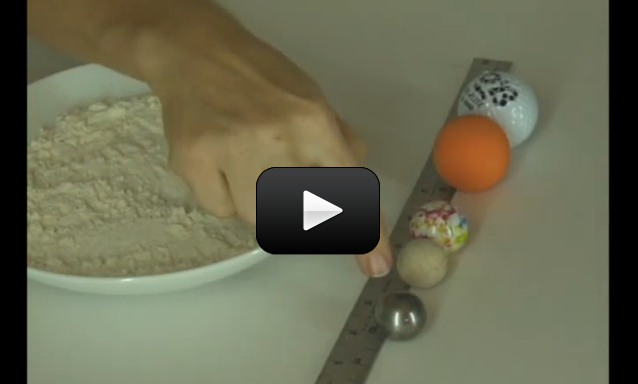In this experiment, you’re looking for two different things: first you’ll be dropping objects and making craters in a bowl of flour to see how energy is transformed from potential to kinetic, but you’ll also note that no matter how carefully you do the experiment, you’ll never get the same exact impact location twice.
To get started, you’ll need to gather your materials for this experiment. Here’s what you need:
[am4show have=’p8;p9;p15;p42;p88;p92;’ guest_error=’Guest error message’ user_error=’User error message’ ]
- several balls of different weights no bigger then the size of a baseball (golf ball, racket ball, ping pong ball, marble etc. are good choices)
- fill a good size container or mixing bowl with flour or corn starch (or any kind of light powder)
- If you’re measuring your results, you’ll also need a tape measure (or yard stick) and a spring scale (or kitchen scale).
Are you ready?
1. Fill the container about 2 inches or so deep with the flour.
2. Weigh one of the balls (If you can, weigh it in grams).
3. Hold the ball about 3 feet (one meter) above the container with the flour.
4. Drop the ball.
5. Whackapow! Now take a look at how deep the ball went and how far the flour spread. (If all your balls are the same size but different weights it’s worth it to measure the size of the splash and the depth the ball went. If they are not, don’t worry about it. The different sizes will effect the splash and depth erratically.
6. Try it with different balls. Be sure to record the mass of each ball and calculate the potential energy for each ball.
Each one of the balls you dropped had a certain amount of potential energy that depended on the mass of the ball and the height it was dropped from. As the ball dropped the potential energy changed to kinetic energy until, “whackapow”, the kinetic energy of the ball collided with and scattered the flour. The kinetic energy of the ball transferred kinetic energy and heat energy to the flour.
For Advanced Students:
[/am4show][am4show have=’p9;p42;’ guest_error=’Guest error message’ user_error=’User error message’ ]
Calculate the gravitational potential energy of the ball. Take the mass of the ball, multiply it by 10 m/s2 and multiply that by 1 meter. For example, if your ball had a mass of 70 grams (you need to convert that to kilograms so divide it by 1000 so that would be .07 grams) your calculation would be
PE=.07 x 10 x 1 = .7 Joules of potential energy.
So, how much kinetic energy did the ball in the example have the moment it impacted the flour? Well, if all the potential energy of the ball transfers to kinetic energy, the ball has .7 Joules of kinetic energy.
Create a table in your science journal or use ours. (You’ll need Microsoft Excel to use this file.)
[/am4show]


There’s a how-to video –
Go to this page:
https://www.sciencelearningspace2.com/science-with-aurora/
and look at the 2nd video down (under “Data Table”)
This video outlines how to create your own data table.
For this experiment, I might change the drop height to see if it changes the pattern made in the flour… just one idea.
Hi how should we journal this
Okay, I think I’m starting to understand. Our 10 gram marble would have .1 joule of energy. Thank you! 🙂
Almost… you have to multiply the weight, which is mass times gravity, by the height so the equation is: PE = mgh.
For the example, it’s (0.070 kg) x (10 m/s2) x (1 meter) = 0.7 Joules of energy!
What do you think it is for your 10 gram marble?
How do you calculate the potential energy, as directed in step 6? I’m just checking, is it the mass of the ball times the height of the drop? Would the result be called Joules of potential energy?
So our marble was 10 grams, dropped from the height of 1 meter, so that would be 10 joules of potential energy? I’m confused, sorry. Thank you!
whackapow
Nice. For some reason our balls didn’t make a big impression 🙂 but =) they sure made a mess. We had a really heavy golf ball, but it did not really make an impression.
/br/> sevy keble 🙂